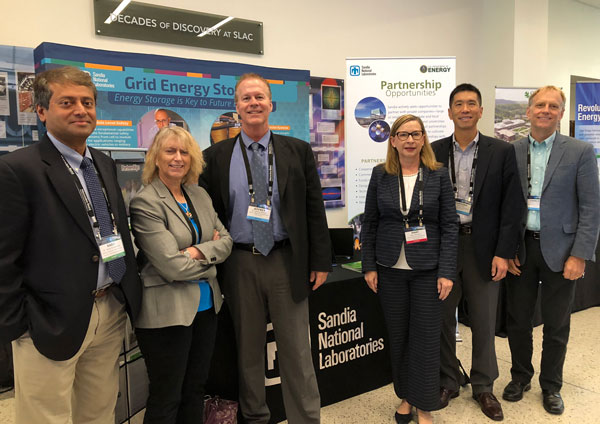Sandia attends DOE’s first-ever Innovation XLab commercialization and innovation of energy technologies
A Sandia team attended DOE’s first-ever Innovation XLab — an event targeting the commercialization and innovation of energy technologies. This particular Innovation XLab focused on energy storage, an essential tool for a reliable, resilient, and flexible power grid and electric vehicles.
Private companies, investors, universities, national laboratories, government officials and other organizations convened at SLAC National Accelerator Laboratory Sept. 18-19 to showcase and view the broad array of technical resources available from across DOE’s national lab complex that can be leveraged by industry to address energy storage challenges. Representatives of the private companies and investor communities also shared their needs

and perspectives relative to energy storage technology and innovation in the future.
“It’s a first-of-its-kind event focused on innovation and technology transfer,” said senior manager Mary Monson. “DOE is going to the investor community, not just inviting companies to attend.” She said she particularly enjoyed the keynote provided by Steve Westly, founder and managing partner of the Westly Group, who had served on the secretary of energy’s advisory board representing the venture capital industry.
“The talk emphasized the rapid, global changes across the energy and transportation sectors,” Mary explained. “He focused on energy production and consumption forecasts, such as the increase in electric vehicles, to illustrate how the future — in a way — is here. And he challenged the national labs to see their part in that future and to be a part of making it happen.”
Sessions ranged from discussions about how to unlock the potential of energy storage (presented by General Electric’s Energy Storage CEO) to a live-streamed fireside chat including Paul Dabbar, the DOE undersecretary for science.
Associate Labs Director Dori Ellis attended the event where several Sandians contributed, including Babu Chalamala, manager of energy storage.
“We gave a good impression of what the labs have,” Babu explained. “We had good interactions, good discussion with the audience.”
Jeff Nelson, senior manager, contributed to Lab Technology Pitches, working with Los Alamos National Laboratory to pitch how advanced polymer membrane technologies could enable the next generation energy economy. The pitch was one of five lab pitch presentations on high-potential beyond Lithium technologies during one of many break-out sessions during the event.
Mary joined a panel on how to engage with the DOE national labs on IP and tech partnerships. The panel addressed myths and surprises associated with the process.
In tandem with the summit, DOE announced that it plans to provide $120 million over five years to renew the Joint Center for Energy Storage Research, a DOE Energy Innovation Hub devoted to advancing battery science and technology, led by Argonne National Laboratory. JCESR, of which Sandia is a partner, was established in 2012 to establish transformative materials for batteries.
The summit also heralded the announcement of 10 new projects to extend grid energy storage. Under the ARPA-E DAYS (Duration Addition to electricitY Storage) program, the projects “will develop energy storage systems to provide reliable, affordable power to the electric grid for up to 100 hours, enhancing grid resilience and performance,” according to a DOE news release.
The next summit will be held in Seattle and focus on the electric grid. Those who have grid technology or research to highlight, should contact Mary at mamonso@sandia.gov.